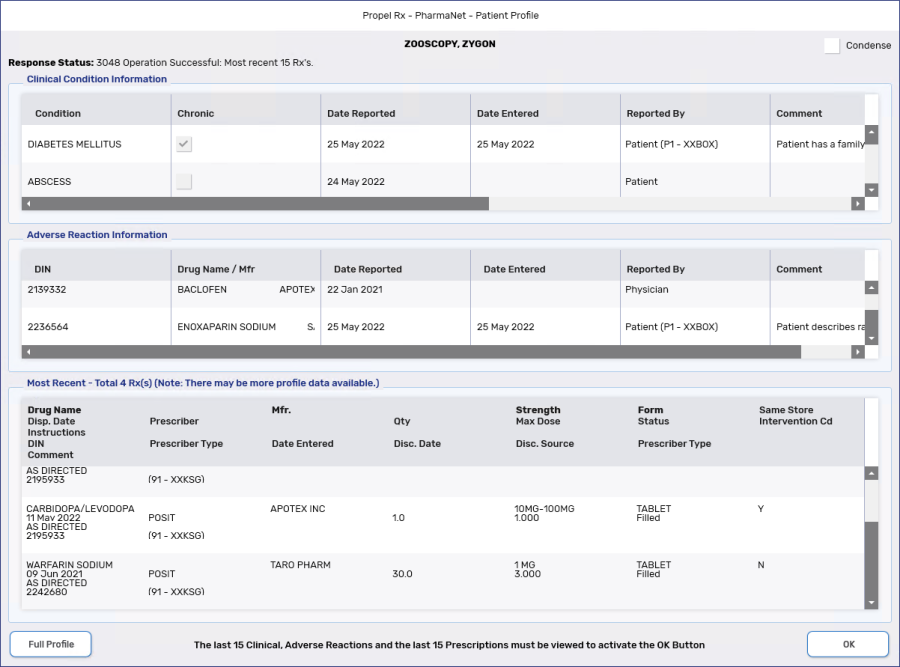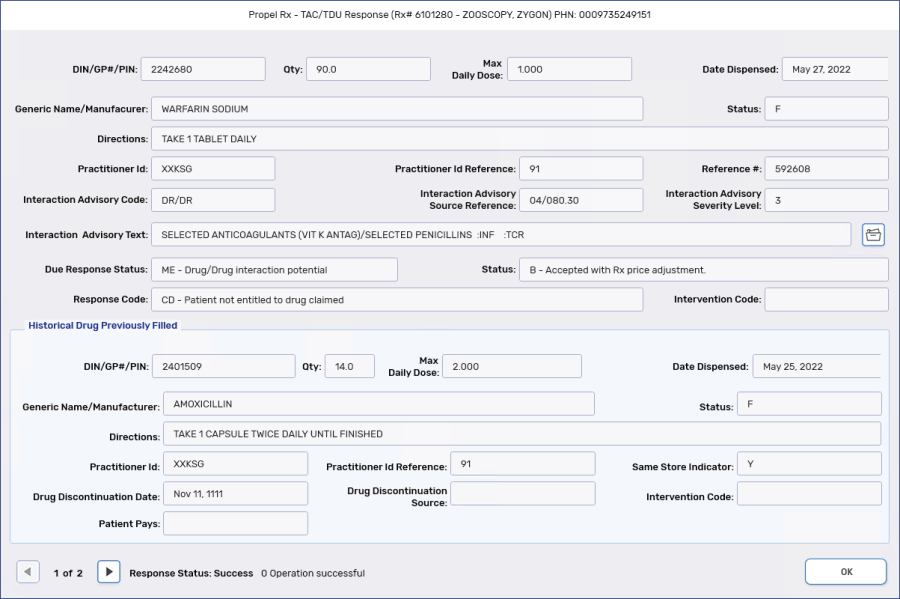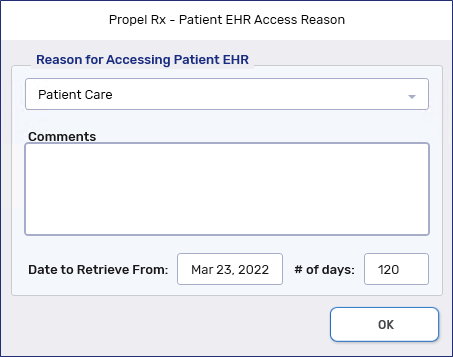Processing Prescriptions from the Data Entry Queue
prescriptions are placed in the Data Entry queue through multiple methods:
-
From the Intake window once Add to Workbench has been selected.
This allows someone to gather the prescription and confirm information from the patient, and adjudicate the prescription at another workstation or a later time.
-
From Rx Detail if the prescription is not processed through adjudication.
-
prescriptions submitted through PrescribeIT®.
-
prescriptions enrolled in the Auto Refill program that had adjudication issues.
In British Columbia, prescriptions enrolled in Auto Refill are not automatically processed. They display on the Workflow tile in the Data Entry queue to be manually processed.
Select the applicable tab to learn about processing prescriptions from the Data Entry queue in your province.
To process a prescription from the Data Entry queue:
-
From the Workbench, select the Data Entry queue. Prescriptions that are currently in the Data Entry queue display in the prescription grid.

-
Select the prescription(s) that need to be processed.
-
Select Process. The prescription opens in one of the following windows, depending on where it is in the Data Entry process:
-
Intake window. Proceed to step 4.
-
Rx Detail window. Proceed to step 6.
-
-
Enter any information that has not already been entered when the prescription was originally taken.
To search for the drug, if you have a scanner attached to the workstation, you can scan the UPC of the bottle.
-
Select Process. The prescription opens in Rx Detail.
If the drug is already on the patient's Profile, a Duplicate Checking prompt appears. For more information, see Duplicate Checking.
-
Verify the information in Rx Detail and make any necessary changes.
-
Select Fill to adjudicate the prescription.
If the prescription is supposed to be put on HOLD, select Hold instead of Fill.
-
The patient's PharmaNet Profile opens. The Profile displays information about the patient's clinical conditions, adverse reactions, and prescription history. You must view the last 15 clinical conditions, adverse reactions, and prescription records before the OK button is enabled.
When filling a succession of prescriptions, the PharmaNet Profile displays only once before the first prescription is filled.

-
Select OK.
-
The TAC/TDU Response window opens. It shows the response from PharmaNet for the submitted prescription and the patient's historical data related to the drug. The window is read only and cannot be modified. Use the arrow button
 to review each page, if there is more than one. Select OK.
to review each page, if there is more than one. Select OK.The TAC/TDU Response window appears for each prescription that is processed. Batched prescriptions are not completed until the TAC/TDU Response windows are viewed.

-
The Claim Summary window opens. Information from PharmaNet is displayed in the Claim Response Message section including:
-
Plan information (i.e. expiry date)
-
Pricing information (i.e. LCA/RBP pricing, fee)
-
Drug information (i.e. special authority, benefit status)
-
Restrictions
Review the window and make any necessary waives.
The PharmaNet response messages are not stored in the prescription. This means you cannot detail the prescription afterwards to view the messages. Codes are printed on the receipt which correspond to the messages.
-
-
Select OK.
If the patient already has a record of this medication on their Profile, a Duplicate Checking prompt appears to confirm how to handle the new prescription.

To gain better insight on how to handle the new prescription, the Duplicate Checking prompt displays information about the existing prescription on file, such as:
-
Rx#
-
Quantity filled
-
Days supply
-
refills remaining
Based on the information displayed, select one of the following:
-
Refill - refills the prescription currently on file.
-
ReAuth - reauthorizes the existing prescription on file, voiding any repeats remaining.
-
New Rx - creates a new prescription and does not link it to the current prescription on file.
-
Cancel - returns to the Intake window.
To process a prescription from the Data Entry queue:
-
From the Workbench, select the Data Entry queue. Prescriptions that are currently in the Data Entry queue display in the prescription grid.

-
Select the prescription(s) that need to be processed.
-
Select Process. The prescription opens in one of the following windows, depending on where it is in the Data Entry process:
-
Intake window. Proceed to step 4.
-
Rx Detail window. Proceed to step 6.
-
-
Enter any information that has not already been entered when the prescription was originally taken.
To search for the drug, if you have a scanner attached to the workstation, you can scan the UPC of the bottle.
-
Select Process. The prescription opens in Rx Detail.
If the drug is already on the patient's Profile, a Duplicate Checking prompt appears. For more information, see Duplicate Checking.
-
The Patient EHR Access Reason window opens if the patient's EHR Profile has not been viewed yet. Select a reason for accessing the patient's EHR Profile and enter any additional comments if needed. Select OK.

Review the patient's EHR Profile and select OK once done.
-
Verify the information in Rx Detail and make any necessary changes.
-
Select Fill to adjudicate the prescription.
If the prescription is supposed to be put on HOLD, select Hold instead of Fill.
-
If there are any Detected Issues, the Detected Issues Maintenance window opens. Review the window and add any appropriate Issue Management codes as needed.
-
Select OK.
-
The Claim Summary window opens. Review the window and make any necessary waives.
-
Select OK.
If the patient already has a record of this medication on their Profile, a Duplicate Checking prompt appears to confirm how to handle the new prescription.

To gain better insight on how to handle the new prescription, the Duplicate Checking prompt displays information about the existing prescription on file, such as:
-
Rx#
-
Quantity filled
-
Days supply
-
refills remaining
Based on the information displayed, select one of the following:
-
Refill - refills the prescription currently on file.
-
ReAuth - reauthorizes the existing prescription on file, voiding any repeats remaining.
-
New Rx - creates a new prescription and does not link it to the current prescription on file.
-
Cancel - returns to the Intake window.
To process a prescription from the Data Entry queue:
-
From the Workbench, select the Data Entry queue. Prescriptions that are currently in the Data Entry queue display in the prescription grid.

-
Select the prescription(s) that need to be processed.
-
Select Process. The prescription opens in one of the following windows, depending on where it is in the Data Entry process:
-
Intake window. Proceed to step 4.
-
Rx Detail window. Proceed to step 6.
-
-
Enter any information that has not already been entered when the prescription was originally taken.
To search for the drug, if you have a scanner attached to the workstation, you can scan the UPC of the bottle.
-
Select Process. The prescription opens in Rx Detail.
If the drug is already on the patient's Profile, a Duplicate Checking prompt appears. For more information, see Duplicate Checking.
-
Verify the information in Rx Detail and make any necessary changes.
-
Select Fill to adjudicate the prescription.
If the prescription is supposed to be put on HOLD, select Hold instead of Fill.
If the patient already has a record of this medication on their Profile, a Duplicate Checking prompt appears to confirm how to handle the new prescription.

To gain better insight on how to handle the new prescription, the Duplicate Checking prompt displays information about the existing prescription on file, such as:
-
Rx#
-
Quantity filled
-
Days supply
-
refills remaining
Based on the information displayed, select one of the following:
-
Refill - refills the prescription currently on file.
-
ReAuth - reauthorizes the existing prescription on file, voiding any repeats remaining.
-
New Rx - creates a new prescription and does not link it to the current prescription on file.
-
Cancel - returns to the Intake window.